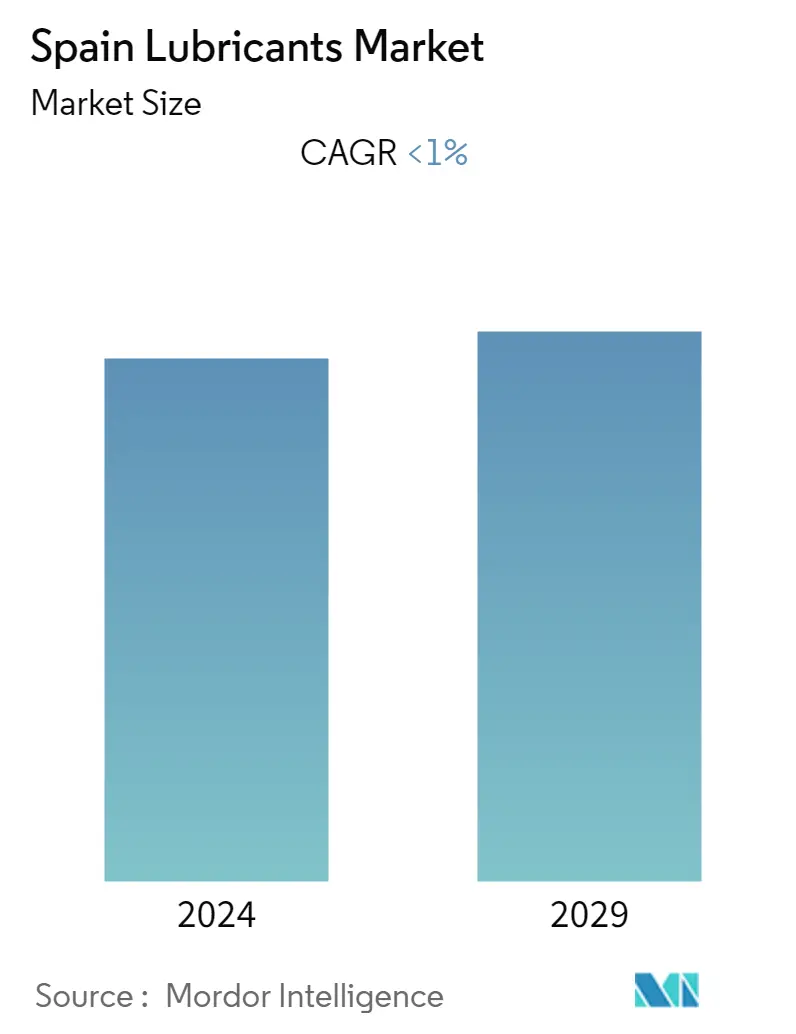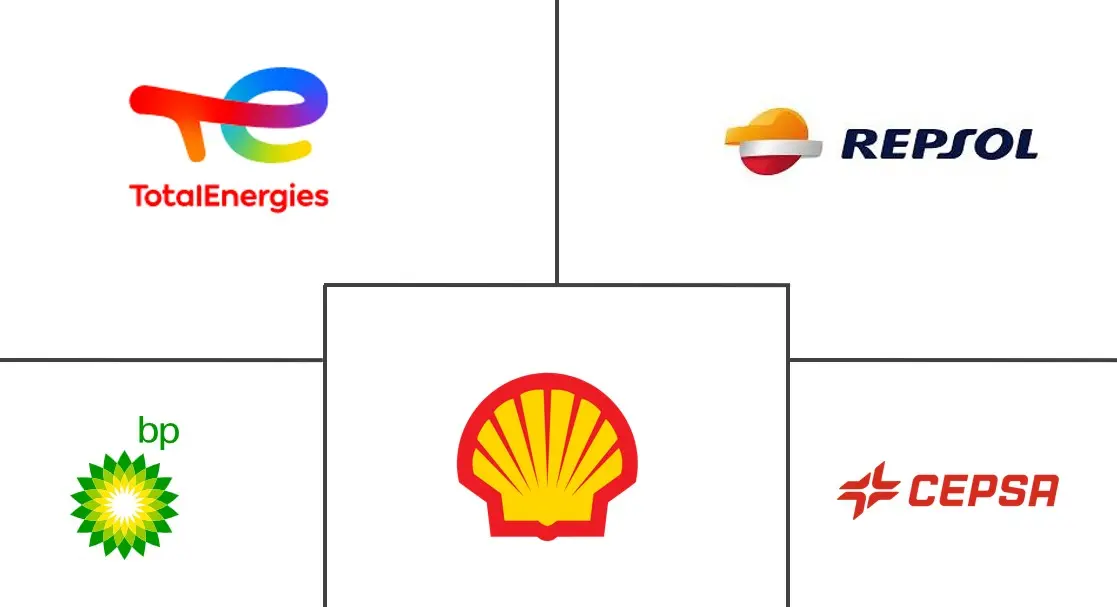Market Size of Spain Lubricants Industry

| Study Period | 2019 - 2029 |
| Base Year For Estimation | 2023 |
| Forecast Data Period | 2024 - 2029 |
| Historical Data Period | 2019 - 2022 |
| CAGR | 1.00 % |
| Market Concentration | High |
Major Players
*Disclaimer: Major Players sorted in no particular order |
Spain Lubricants Market Analysis
The Spain Lubricants Market is estimated to reach 378.21 million l by the end of this year and is projected to reach 382.54 l in the next five years, registering a CAGR of less than 1% during the forecast period.
The impact of COVID-19 on the lubricants market was adverse in Spain. Demand from the major automotive segment witnessed a steep fall owing to the decline in sales units of vehicles. However, the demand substantially recovered with the reopening of 2021 but remained way below the pre-pandemic levels.
- One of the major drivers for lubricant demand in Spain is the consistent increase in investments in the power generation industry.
- However, the growing production of electric vehicles will likely restrain the growth of the lubricants market in Spain.
- Growing research and developments in synthetic and bio-based lubricants will likely create opportunities for the market studied in the coming years.
Spain Lubricants Industry Segmentation
Any substance physically integrated to reduce friction between two or more moving surfaces is called a lubricant. On metallic surfaces, lubricants aid in preventing material degradation, erosion, corrosion, and rust development. Lubricants are typically made up of 90% petroleum-based oil and various additives to give them desirable properties specific to a given purpose.
The Spain lubricants market is segmented by product type and end-user industry. By product type, lubricants are segmented into engine oils, greases, hydraulic fluids, metalworking fluids, transmission and gear oils, and other product types (process oils, circulating oils, aviation oils, etc.). By end-user industry, lubricants are segmented into automotive, heavy equipment, metallurgy and metalworking, power generation, and other end-user industries (food and beverage, chemical manufacturing, textile, etc.). The report covers market sizing and forecasts for each segment in volume (liters).
| Product Type | |
| Engine Oils | |
| Greases | |
| Hydraulic Fluids | |
| Metalworking Fluids | |
| Transmission and Gear Oils | |
| Other Product Types (Process Oils, Circulationg Oils, Aviation Oils, etc.) |
| End-user Industry | |
| Automotive | |
| Heavy Equipment | |
| Metallurgy and Metalworking | |
| Power Generation | |
| Other End-user Industries (Food and Beverage, Chemical Manufacturing, Textile, etc.) |
Spain Lubricants Market Size Summary
The Spain lubricants market is experiencing a gradual recovery following the adverse impacts of the COVID-19 pandemic, which significantly affected demand, particularly in the automotive sector. The market is driven by increasing investments in the power generation industry, where high-performance lubricants are essential for the reliability and efficiency of equipment such as turbines and generators. The shift towards renewable energy, especially wind power, has been a significant factor in this demand, with Spain aiming to enhance its renewable energy capacity significantly by 2030. This transition is supported by both government and private sector investments, which are expected to bolster the lubricants market in the coming years.
Despite the positive outlook in the power generation sector, the growing production of electric vehicles poses a challenge to the lubricants market, as these vehicles require less lubrication. The automotive industry, a major consumer of engine oils, has seen a decline in traditional vehicle production and sales, although there is a rise in electric and hybrid vehicle registrations. This trend is likely to continue impacting the market negatively. However, the construction industry, with its ongoing large-scale projects, continues to drive demand for engine oils used in heavy-duty equipment. The market is consolidated, with key players like BP p.l.c., Cepsa, Repsol, Shell Plc, and TotalEnergies SE playing significant roles in shaping its dynamics.
Spain Lubricants Market Size - Table of Contents
-
1. MARKET DYNAMICS
-
1.1 Market Drivers
-
1.1.1 Growing Investments in Power Generation Industry
-
1.1.2 Growing Demand for Agricultural Machinery
-
1.1.3 Other Drivers
-
-
1.2 Market Restraints
-
1.2.1 Growing Penetration of Electric Vehicles
-
1.2.2 Other Restraints
-
-
1.3 Industry Value Chain Analysis
-
1.4 Porter's Five Forces Analysis
-
1.4.1 Bargaining Power of Suppliers
-
1.4.2 Bargaining Power of Buyers
-
1.4.3 Threat of New Entrants
-
1.4.4 Threat of Substitute Products
-
1.4.5 Degree of Competition
-
-
-
2. MARKET SEGMENTATION (Market Size in Volume)
-
2.1 Product Type
-
2.1.1 Engine Oils
-
2.1.2 Greases
-
2.1.3 Hydraulic Fluids
-
2.1.4 Metalworking Fluids
-
2.1.5 Transmission and Gear Oils
-
2.1.6 Other Product Types (Process Oils, Circulationg Oils, Aviation Oils, etc.)
-
-
2.2 End-user Industry
-
2.2.1 Automotive
-
2.2.2 Heavy Equipment
-
2.2.3 Metallurgy and Metalworking
-
2.2.4 Power Generation
-
2.2.5 Other End-user Industries (Food and Beverage, Chemical Manufacturing, Textile, etc.)
-
-
Spain Lubricants Market Size FAQs
What is the current Spain Lubricants Market size?
The Spain Lubricants Market is projected to register a CAGR of less than 1% during the forecast period (2024-2029)
Who are the key players in Spain Lubricants Market?
BP p.l.c., Cepsa, Repsol, Shell Plc and TotalEnergies SE are the major companies operating in the Spain Lubricants Market.

